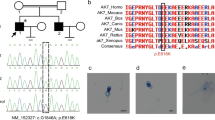Abstract
Purpose
Recent studies have shown that genetic abnormalities may be responsible for most unknown cases of male infertility. Human Nsun7 gene, which is located on chromosome4, has a role in sperm motility by encoding the putative methyltransferase Nsun7 protein. The aim of the present study was to investigate the mutations of exon4 in the Nsun7 gene, which is associated with sperm motility defect.
Methods
Semen samples including those of fertile normospermic (normal), infertile oligospermic (with normal sperm motility), and infertile asthenospermic (with reduced sperm motility) men were collected from the Omid and Fatemezahra IVF centres (Babol, Iran). These samples were then analysed on the basis of World Health Organization guidelines using the general phenol–chloroform DNA extraction method. Exon4 was amplified using Sun-F/Sun-R primers. Samples from asthenospermic men, which showed different patterns of movement on single-strand conformation polymorphism compared with normal and oligospermic samples, were identified and subjected to sequencing for further identification of possible mutations.
Results
Analysis of extracted sperm proteins showed that the rate of Nsun7 decreased. Likewise, direct sequencing of PCR products, along with their analysis, confirmed the deletion mutation of adenine in location 11337 of the Nsun7 gene in asthenospermic men. Comparison of normal and mutant protein structures of Nsun7 indicated that the A11337-deletion of the exon4 resulted in the valine residues-157 with GTA-codon in normospermic replaced with TAG-early stop codon in asthenospermic samples, causing an abortive protein product with amino acid sequence shorter than normal. The secondary structure of the protein, the protein folding, and ligand binding sites were changed, indicating the impairment of the protein function.
Conclusions
Because the Nsun7 gene products have a role in sperm motility, it will lead to impairment in the activity of the protein and motility of sperm flagella as well as male infertility if a mutation occurs in this gene.







Similar content being viewed by others
References
Gnoth C, Godehardt E, Frank-Herrmann P, Friol K, Tigges J, Freundl G. Definition and prevalence of subfertility and infertility. Hum Reprod. 2005;20(5):1144–7.
World Health Organization. Laboratory manual for the examination of human semen and semencervical mucus interaction. Cambridge: Cambridge University Press; 1992.
Zhou DX, Wang HX, Zhang J, Gao XL, Zhao WB. Di-n-butylphthalate (DBP) exposure induces oxidative damage in testes of adult rats. Syst Biol Reprod Med. 2010;6(6):413–9.
Zhou DX, Wang HX, Zhang J. Di-n-butyl phthalate (DBP)exposure induces oxidative stress in epididymis of adult rats. Toxicol Ind Health. 2011;27:65–71.
Zhou DX, Zhang J, Wang HX. Assessment of the potential reproductive toxicity of long-term exposure of adult male rat’s tolow-dose formaldehyde. Toxicol Ind Health. 2011;27(7):591–8.
Kretser DM, Baker HW. Infertility in men: recent advances and continuing controversies. J Clin Endocrinol Metab. 1999;84(10):3443–50.
Irvine DS. Epidemiology and aetiology of male infertility. Hum Reprod. 1998;3:33–44.
Zhang Y, Malekpour M, Al-Madani N, Kahrizi K, Zanganeh M, Lohr NJ. Sensorineural deafness and male infertility: a contiguous gene deletion syndrome. J Med Genet. 2007;44:233–40.
Shamsi MB, Kumar K, Dada R. Genetic and epigenetic factors: role in male infertility. Indian J Urol. 2011;27:110–20.
Ferlin A, Raicu F, Gatta V, Zuccarello D, Palka G, Foresta C. Male infertility: role of genetic background. Reprod Biomed Online. 2007;14:734–45.
Vogt PH. Molecular genetic of human male infertility from genes to new therapeutic perspectives. Curr Pharm Des. 2004;10:1–30.
Liska F. Selected genetic aspects of male infertility-what animal models tell us. Folia Biol (Praha). 2003;49:129–41.
Gilbert SF. Developmental biology. 6th ed, Chaptet 7 & 19, Sunderland (MA), Sinauer Associates. 2000.
Spiropoulos J, Turnbull DM, Chinnery PF. Can mitochonderial DNA mutations cause sperm dysfuunction? Mol Hum Reprod. 2002;8:719–21.
Turner RM. Moving to the beat: a review of mammalian sperm motility regulation. Reprod Fertil Dev. 2006;18:25–38.
Harris T, Marquez B, Suare S, Schimenti J. Sperm motility defects and infertility in male mice with a mutation in Nsun7, a member of the sun domain-containing family of putative RNA methyltransferases. Biol Reprod. 2007;77:376–82.
Khosronezhad N, Hosseinzadeh-Colagar A, Jorsaraei G. T26248G-transversion mutation in exon7 of the putative methyltransferase Nsun7 gene causes a change in protein folding associated with reduced sperm motility in asthenospermic men. Reprod Fertil Develop. 2014. doi:10.1071/RD13371.
World Health Organization. Laboratory manual for the examination of human semen and semen–cervical mucus interaction. 4th ed. Cambridge: Cambridge University Press; 1999.
Green MR, Sambrook J. Molecular cloning: a laboratory manual. 4th ed. Cold Spring Harbor: Cold Spring Harbor Laboratory Press; 2012.
Jing Z, Dang-xia Z, Hai-xu W, Zhao T. An association study of SPO11 gene single nucleotide polymorphisms with idiopathic male infertility in Chinese Han population. J Assist Reprod Genet. 2011;28:731–6.
Hull MG, Glazener CM, Kelly NJ, Conway DI, Foster PA, Hinton RA, et al. Population study of causes, treatment and outcome of infertility. Br Med J (Clin Res Ed). 1985;291(6510):1693–7.
Hargreave TB. Genetic basis of male fertility. Br Med Bull. 2000;56:650–7.
Nishimune Y, Tanaka H. Infertility caused by polymorphisms or mutations in spermatogenesis-specific genes. J Androl. 2006;27:326–34.
Acknowledgments
Thanks to Dr. Seyed Golam Ali Jorsaraei, from Fatemeh Zahra Hospital (Babol Iran), for sample preparation and persons who helped prepare the manuscript and helped us to revise the paper.
Author information
Authors and Affiliations
Corresponding author
Additional information
Capsule
Our results indicate that there is an association between the exon 4 mutation in Nsun7 gene and sperm motility defect with male infertility in an Iranian population, hence the A11337-Deletion mutation in exon 4 of the Nsun7 gene can be used as an indicator of infertility.
Rights and permissions
About this article
Cite this article
Khosronezhad, N., Hosseinzadeh Colagar, A. & Mortazavi, S.M. The Nsun7 (A11337)-deletion mutation, causes reduction of its protein rate and associated with sperm motility defect in infertile men. J Assist Reprod Genet 32, 807–815 (2015). https://doi.org/10.1007/s10815-015-0443-0
Received:
Accepted:
Published:
Issue Date:
DOI: https://doi.org/10.1007/s10815-015-0443-0




